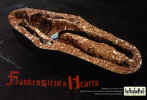 Remember
those teachers who never deviated from their lesson plan, who
delivered meandering, protracted lectures siphoned directly from the
narrow minds at Harcourt Brace? It seems my entire education was
dominated by rambling right-brained soliloquies like these, making
the study of biology or math or even art an act of intense,
unquestioning regurgitation. If only I had had Kim Abeles as my
tutor, someone who could translate language and concepts visually, I
would’ve been as content in the education assembly line as Laverne
and Shirley’s glove.
Remember
those teachers who never deviated from their lesson plan, who
delivered meandering, protracted lectures siphoned directly from the
narrow minds at Harcourt Brace? It seems my entire education was
dominated by rambling right-brained soliloquies like these, making
the study of biology or math or even art an act of intense,
unquestioning regurgitation. If only I had had Kim Abeles as my
tutor, someone who could translate language and concepts visually, I
would’ve been as content in the education assembly line as Laverne
and Shirley’s glove.
Kim Abeles is equal parts artist, activist,
storyteller, and scientist, making her the best kind of public
educator. A socio-political nature and an interest in the cultural
self-image drive much of her work. She has spent most of her career
exploring and explaining issues of immediate social importance, from
AIDS to ecology, from labor relations to racism. She tries to reach
an audience as expansive as her causes, making her art into a
user-friendly soapbox whose vantage point can be just as relevant
and empowering for the audience as it is for her, the artist. While
Abeles’ art has employed a myriad of forms, including sculpture,
assemblage, and photography, detailed research remains its dominant
element.
Take the series called The Smog Collection,
which ended up becoming a mascot of sorts for the California Bureau
of Automotive Repair, Department of Consumer Affairs. The idea went
down like this: When she first arrived in Los Angeles, Abeles
noticed how the horrible quality of the air obscured the view of the
mountains from her studio window. Sometimes even in broad daylight
she could barely see the silhouette of the range. Wanting to
illustrate the effects of smog on her everyday existence, Abeles
placed simple stencils on the surface of her roof and collected air
particulate in the negative space. After she figured out how to get
the smog to stick to a variety of surfaces, she drew on her
experience in portraiture to create the Presidential Smog Plates
(1992). This dinnerware featured the smiling image of every
president since McKinley in the center, with each of their
respective policies on air pollution scripted, in smog, around the
plate’s edge.
Frankenstein’s Hearts,
Abeles’ latest installation, continues the idea of portraiture.
Her passion for the collaborative process of art merges with
storytelling and sculptural assemblage to produce a visual narrative
of life lived through several decades, a multi-layered display of
love stories, war stories, and immigration stories. The project
arose from a partnership with the Youth Acts Collaborative of the
San Francisco Art Institute, kids from St. John’s Educational
Threshold Center, and Abeles’ current students at Cal State
Northridge, as well as local artist Therese Buchmiller. It uses
illustration, assemblage, and written documentation to translate
stories from the community’s elders into a collective visual
language directed toward the project’s centerpiece: a large satin
and copper sarcophagus.
While Abeles’ work has been exhibited throughout
the United States, as well as Canada, Belgium, The Netherlands,
Slovenia, Spain, and the Czech Republic, this is her first solo
exhibition in San Francisco. Her work can be found at the Museum of
Contemporary Art in Los Angeles, the California Afro-American
Museum, and the library collections of the Museum of Modern Art and
the Cooper-Hewitt Publication Design Collection of the Smithsonian.
Kim Abeles is currently the artist-in-residence
for the California Science Center in Los Angeles as well as an
assistant professor in the Department of Art at Cal State
Northridge. I guess that’s where I should’ve gone to avoid the
assembly line.
Sarah
Lidgus